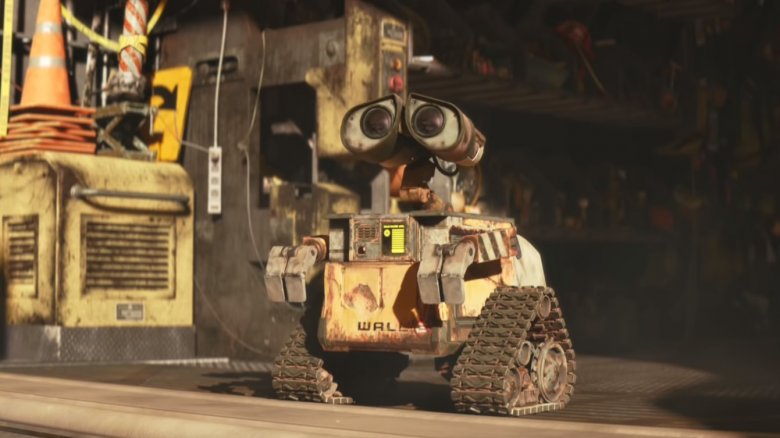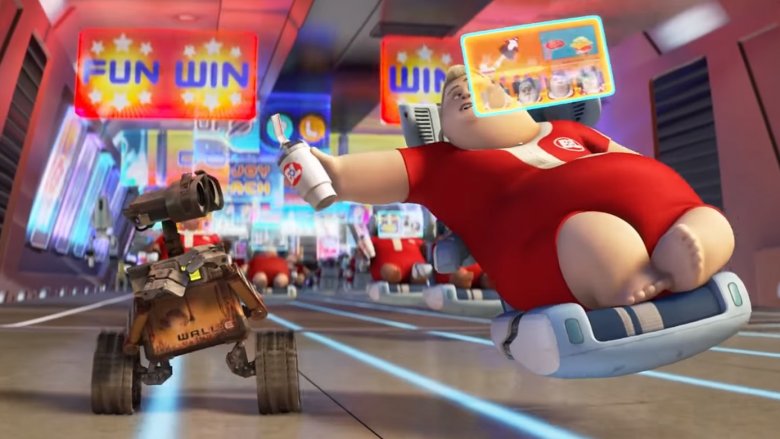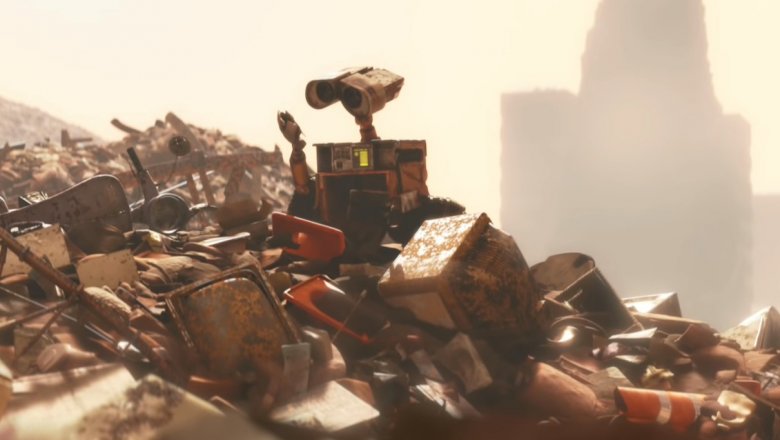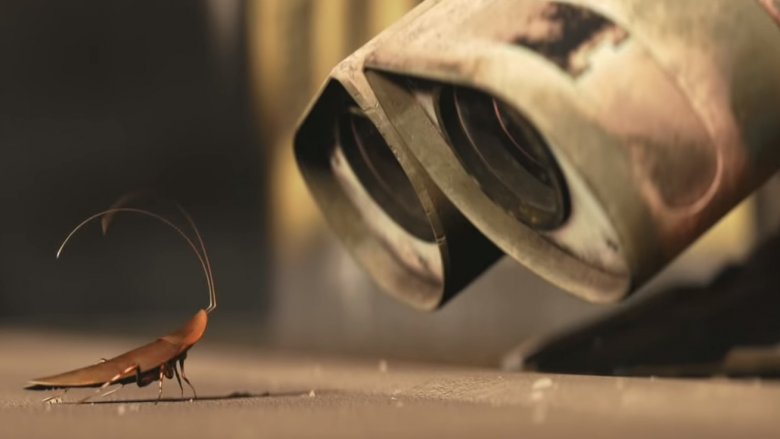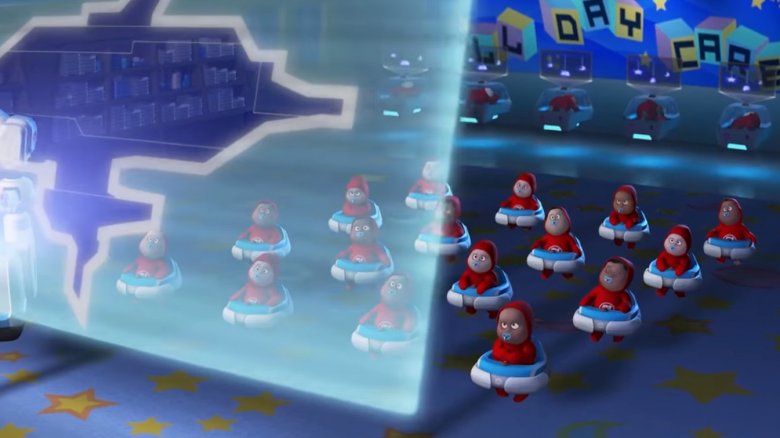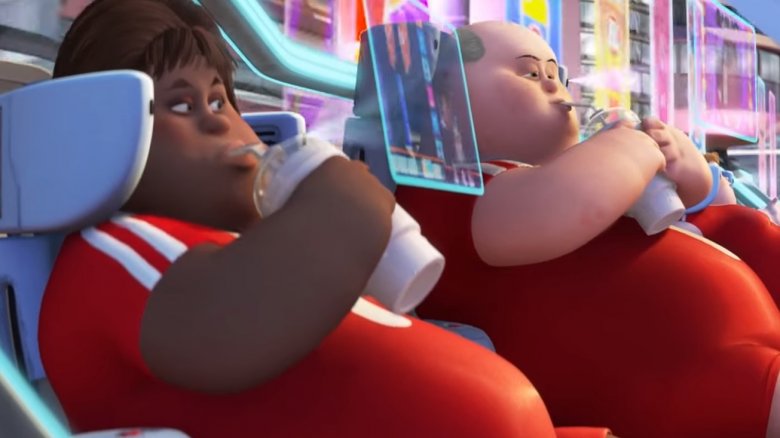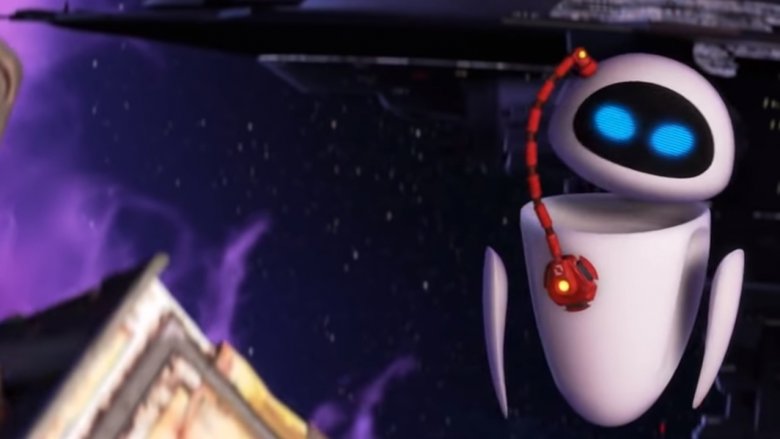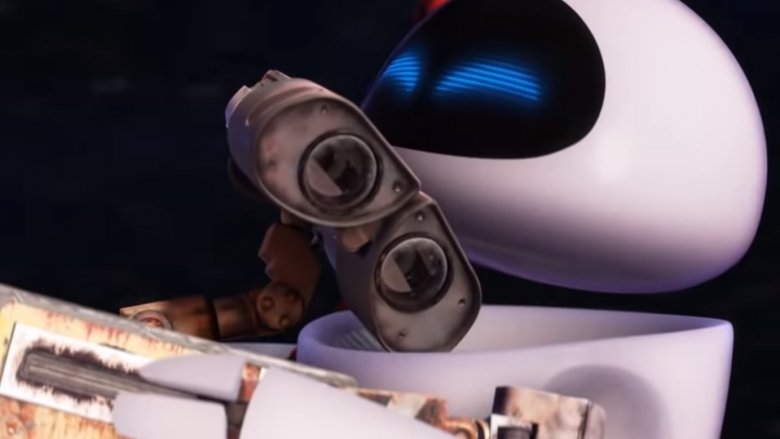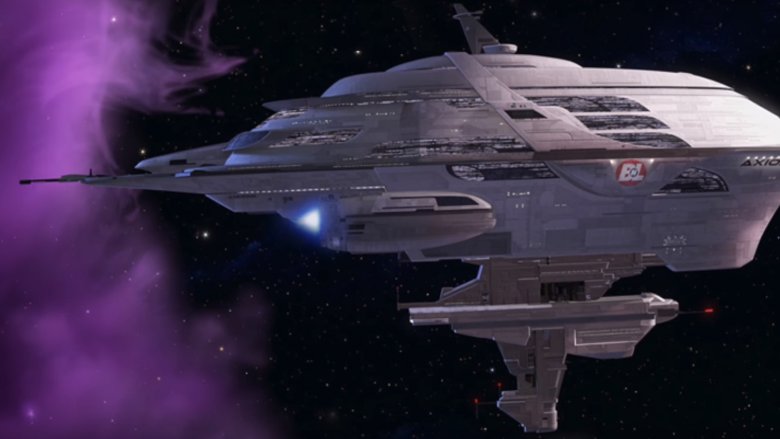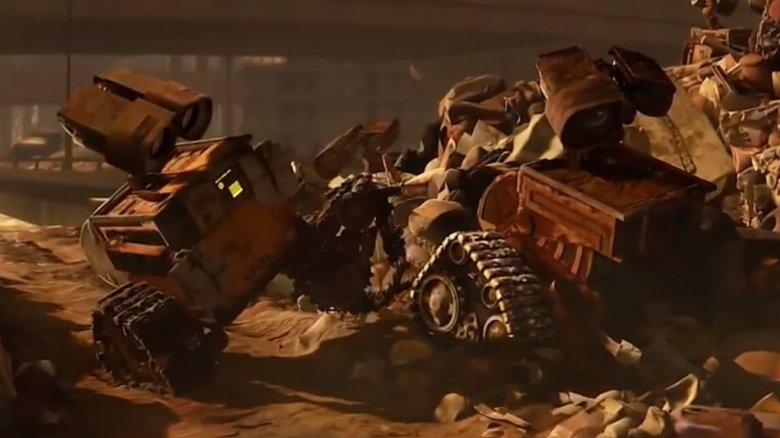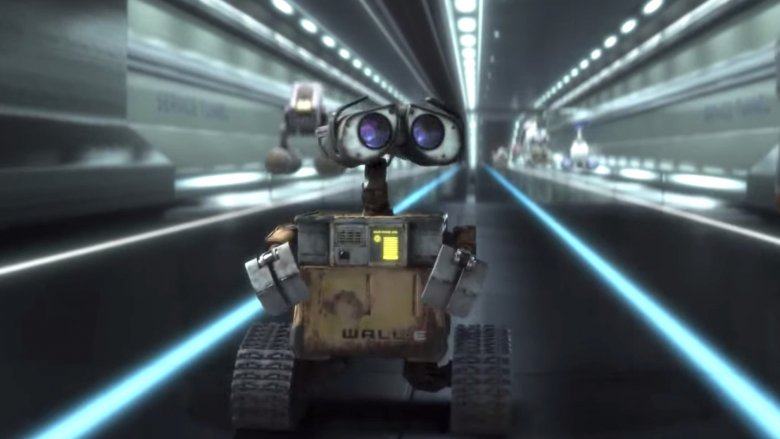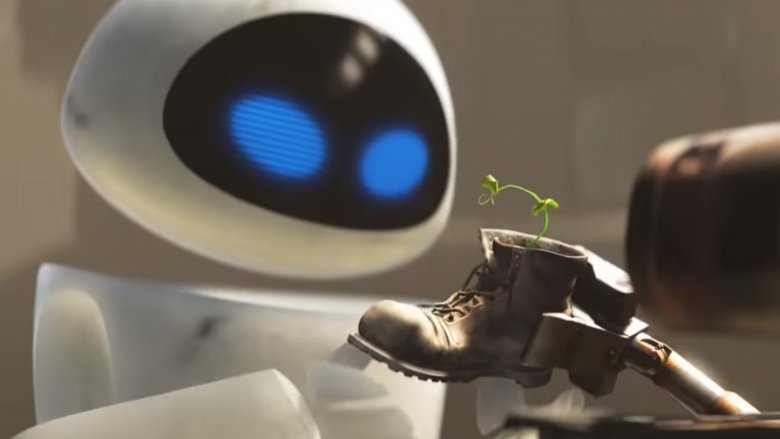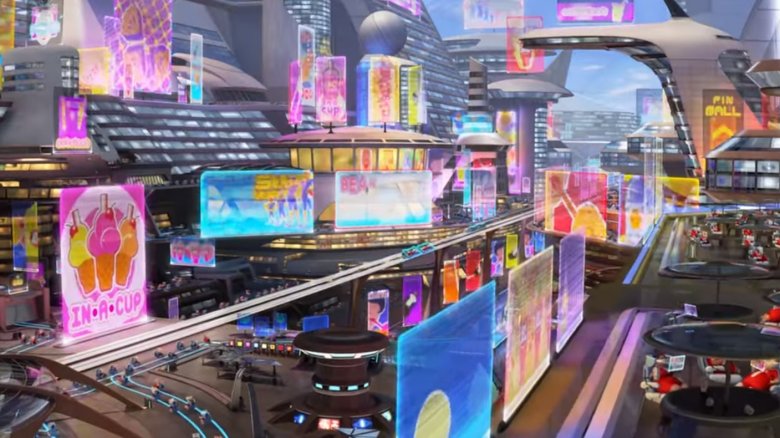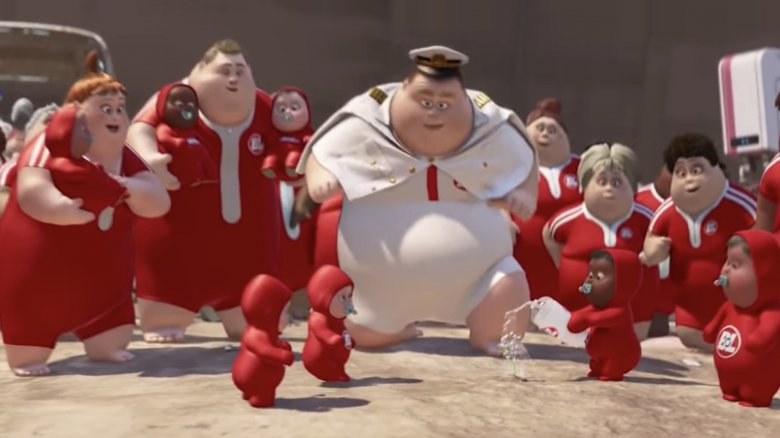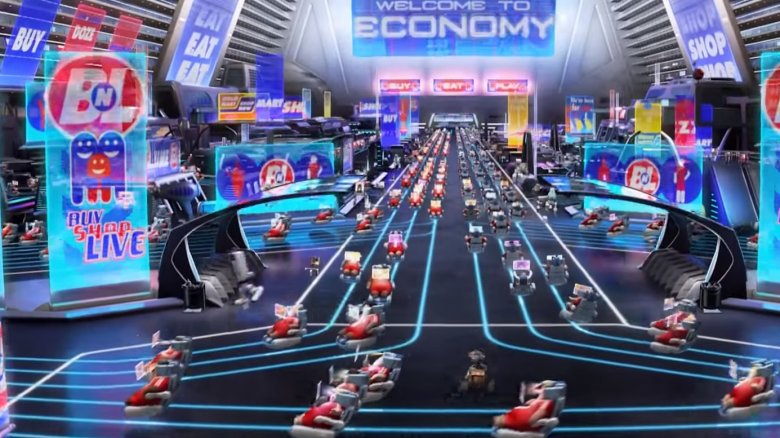Things Only Adults Notice In WALL-E
WALL-E, Disney and Pixar's 2008 offering, boasts a lot to love. The movie charmed children with its stunning animation, memorable characters, and many hilarious and emotional moments. Starring an eponymous trash compactor with a penchant for Hello, Dolly! and the odd and quirky objects he finds while collecting garbage, WALL-E tells the story of what happens when a robot falls in love and unwittingly goes on an adventure to space that changes the course of humanity.
But as with pretty much every Pixar film, there's a lot in WALL-E that kids don't pick up on, but plenty of things that only adults will notice. Whether it's the many shout-outs to the Stanley Kubrick film 2001: A Space Odyssey or a nod to Apple with WALL-E's start-up chimes, there are plenty of little things that make parents smile. But there are also a lot of questions that adults are left with, like how did WALL-E become sentient? And where does all the food on the ship, the Axiom, come from? Read on to discover what only adults picked up on in WALL-E.
WALL-E is wildly fat shaming
It takes a considerable amount of time before viewers of WALL-E see how human beings are depicted in the film. It's only after EVE finds the plant, is picked up by a probe, and is then brought to the Axiom (with WALL-E in tow) that we see any people. And when we do, every single one of them is significantly overweight, and is confined to a hovering chair with a built-in virtual monitor for watching television and communicating. They also consume all of their meals while sitting in their chairs, and are so constantly on their screens that they don't even notice there's a swimming pool.
It's pretty evident that the point is to show that since they don't need to do anything for themselves, the humans in WALL-E are just lazy and complacent. But adults can see that's also a cruel depiction of people who are overweight in real life, as it implies that they're lazy and refuse to move. It's especially insulting to heavy folks who are confined to wheelchairs or mobility devices. Hopefully Pixar won't be so fat-shamingever again!
WALL-E provides a message about climate change
The plot of WALL-E begins approximately 700 years in the future, and it depicts the state of Earth as completely buried in garbage, thanks to the mega-corporation Buy N Large, and relatively inhospitable to human life. That's where viewers are introduced to WALL-E, who goes about the business of collecting and compacting trash on a dusty, hazy planet. So it's quite surprising when he finds a single, tiny plant in a shoe, showing that, while desolate and polluted, Earth still has the capacity to support life.
As it turns out, WALL-E might not be inaccurate about the future of the planet, given the dire predictions scientists have made about climate change. According to NASA, Earth will continue to warm in the future, causing more intense storms and weather, changes in farming seasons, complete ice melts in the Arctic regions during the warm season, and a one to four foot sea level rise by 2100. Given that Buy N Large declared Earth beyond salvageable in 2110 in WALL-E, they're not so far off from what might happen. Kids might not notice that, but, for adults, it's hard to miss!
WALL-E shows the resilience of roaches
Although WALL-E doesn't have much company until EVE shows up and steals his heart, he's not alone on Earth. Rather, his one companion on the trash-buried planet is a single cockroach, who WALL-E keeps as a pet in the living space he has carved out for himself amidst the rubbish.
Disney and Pixar's decision to have the only other living being on Earth be a cockroach makes sense, as cockroaches are extremely resilient insects, according to Smithsonian. Not only are they hard to smash (which WALL-E almost does when he accidentally rolls over his pet, who turns out to be just fine after a brief scare), but they are also capable of living without a head for weeks, surviving nuclear radiation, and holding their breath for super long periods of time. They're even becoming more resistant to pesticides, which isn't a comforting thought to the roach-fearing among us. But the reality is that roaches are some of the toughest living beings out there, and WALL-E definitely acknowledges that, even if kids might miss it.
If the humans on the Axiom never touch, where did the kids come from in WALL-E?
To be honest, life aboard the Axiom looks pretty sweet in WALL-E. You don't have to worry about paying rent or bills, let alone putting food on the table, and literally everything you need to live is provided for you by robots. Of course, there's a trade-off, which is a lack of individual agency, as well as a lack of physical strength, but life on the Axiom really does look like life on a cruise ship.
But adults, especially parents, are going to have some questions when they see that there are children on board the Axiom. Specifically, how did those children get there? How is humanity reproducing if they've never even touched each other, something that becomes glaringly obvious when characters John and Mary brush hands for the first time? The answer is probably something akin to what you read about in a dystopian novel, or a futuristic form of fertility that doesn't require traditional mating habits. But that's speculation at best, as Pixar doesn't make the answer clear.
Where does all the food come from on the Axiom in WALL-E?
In WALL-E, robots take care of everything for the humans on the Axiom, from serving as primary school educators to attending to the hair and makeup needs of anyone on the ship who wants to "feel beautiful." Additionally, the robots are responsible for fetching food for the humans, which is delivered to them directly in their chairs, and, as the ship's computer gleefully announces, "in a cup!"
But one thing that more discerning adults may wonder about is this: where exactly is all of the food on the Axiom coming from? It's obvious that no one on the ship is growing vegetables or tending to livestock, in light of the ending of the film, let alone cooking or preparing foods. And there are no scenes depicting the robots doing either of these activities either, or even using futuristic technology to generate food from some other source. Once again, we're left wondering just where these things are coming from, and we aren't given a clear explanation.
WALL-E's EVE is an independent woman
Who knows just how long WALL-E has been the last robot standing on Earth, collecting trash and holding down the fort after everyone and everything else has gone? But one thing's for sure: Everything changes for WALL-E when EVE comes into his life. From the very second that he lays eyes on her sleek form and digitally sophisticated technology, WALL-E is deeply smitten, despite EVE's repeated attempts to obliterate him with her seriously deadly ammunition. For a long time, WALL-E can only watch EVE from afar, hoping that his romantic gestures endear her to him, which they eventually do.
But even then, EVE is not submissive to WALL-E in any way, and she isn't any less smart, although she does soften as the film progresses. But for the most part, EVE does what EVE wants to do, whether it's showing WALL-E how to dance in space or solving a Rubix Cube in a record amount of time. It's nice to see a female character with such strength and aptitude, even though she's "just" a robot, something adults definitely appreciate.
The limited dialogue between WALL-E and EVE speaks volumes
WALL-E and EVE spend a lot of time together in WALL-E, which, of course, makes sense given that they are the romantic leads of the film. He shows her around his living space, they dance as partners among the stars, and together they ensure that the plant WALL-E found and EVE protected gets to its destination, despite attempts made by AUTO to thwart their mission. There's a lot going on in the plot of WALL-E, for sure.
But something that adults might have noticed is that the dialogue between WALL-E and EVE is really, really limited in its vocabulary. For the most part, all WALL-E ever says to EVE is "EVE," and all EVE ever says to WALL-E is "WALL-E." But despite the super simple words that the pair use, their interactions are often very expressive. That's thanks to the incredible talent of the actors who voice the robots, as they use intonation, volume, grunts, and laughter to give the dialogue a ton of emotional depth. It's actually quite the feat!
Is the Axiom the only ship in the universe in WALL-E?
After human beings were told they had to evacuate earth while all of the WALL-E robots cleaned up the mess, they took up new residencies in outer space. They did so under the impression that this was a temporary arrangement, and they were told they would return when everything was restored to its former glory back home. Obviously that didn't happen, but, thanks to the plant that WALL-E and EVE found, the Axiom returned to Earth at long last, even though it's far from clean.
But if you wondered where the rest of the earth's population was, you're not alone! Although the Axiom is a humongous ship, there's no way it could fit the billions and billions of people who used to live on Earth. To that end, there have to be other ships out there in space with everyone else who was evacuated. But they're never mentioned in WALL-E, so we can only speculate that there are other ships out there. It's only logical!
Shouldn't WALL-E be more bothered when he sees other dead WALL-Es?
If you think about it, WALL-E is a pretty old robot. He was created by Buy N Large along with all of the other WALL-Es when humans left the earth in the early 2100s, which was nearly 700 years before the movie takes place. He's outlived all of the previous captains of the Axiom, and he is the last of his kind left on Earth. So you know he's seen a lot in his time picking up trash.
But that doesn't quite explain why WALL-E isn't really bothered by the sight of other dead WALL-Es. For one, he pillages the lifeless WALL-Es on Earth for parts to upgrade himself without a visible shred of disturbance, despite his incredibly sensitive and romantic nature. And when he's thrown into the trash room on the Axiom with scattered garbage and waste, including WALL-E parts, he doesn't really react to that either. While kids might not pick up on that weirdness, it can throw adults for a loop. Has he no regard for his dead homies?
How did WALL-E become sentient anyway?
When viewers are introduced to WALL-E at the beginning of the film, he's dutifully doing the job that he was programmed to do, which is to collect, compact, and organize the trash that's been left behind on Earth. During those first few seconds, there's no indication that he has a personality — until he stops what he's doing and parses out a piece of trash that he wants to keep. That's when it becomes clear that WALL-E is much more than what he was engineered to be, as he's a sentient being who jams to Hello, Dolly! on the job.
But adults wonder: just how did WALL-E become sentient anyway? And why just him and not the other WALL-Es? Adults might have put together some theories, including one in which he was struck by lightning, which woke him up to life as a sentient being. After all, he does get struck by lightning not once but twice in WALL-E while protecting the dormant EVE in a rain storm, and is relatively unfazed. And it's a spark from EVE that restores WALL-E's personality, resurrecting him from default mode at the end of the movie. Maybe that's what happened?
EVE juggles her work and her romance in WALL-E
Just as WALL-E has been programmed to collect and compact garbage on planet Earth, so too has EVE been assigned a clear directive from her creators out of the gate: find evidence that Earth can grow crops and deliver proof of that to the Axiom. So when WALL-E shows EVE the plant that he found growing in a shoe, she grabs the plant and then shuts down. EVE then enters an unresponsive mode where her only concern is protecting the little green sprig until the probe can deliver her to the Axiom, much to WALL-E's dismay.
As the film progresses, however, EVE's affections for WALL-E cause her to want more than just what she was programmed for, as she's developed romantic feelings for him. So even though her goal in life is to find and protect the plant at all costs, she also takes time away from that to protect WALL-E and save him from losing both his sentience and his life. Fortunately, EVE is able to juggle her work-life balance and get both jobs done, which moms especially can surely appreciate.
There's a reason Sigourney Weaver voices the ship's computer in WALL-E
Life on the Axiom would be impossible without the help of the many robots on its staff. From delivering food to styling hair and makeup to charting the course that the ship takes, robots are front and center in keeping things running while humans on board remain passive and engaged in their own endeavors. Robots are also responsible for the cleanliness of the Axiom, as well as ensuring that all of the humans are safe from any potential harm.
Additionally, a robot voice is responsible for telling humans what's going on in the world, which is usually something related to Buy N Large. And if you have a particularly astute ear, you'll notice that it's Sigourney Weaver who voices the Axiom's main computer — and that's no accident. That's because Weaver was the star of the groundbreaking and seminal film Alien, and WALL-E director Andrew Stanton loves sci-fi films, according to an article in the Los Angeles Times. Kids might not pick up on the shout-out, but plenty of adults did.
Um… why would the humans in WALL-E leave the Axiom for Earth?
At the end of WALL-E, thanks to the brave and moral actions of EVE, WALL-E, and the captain, the Axiom returns home to Earth. The humans are ready to roll up their sleeves and get to work, restoring the planet to its former glory. During the final scenes of the film, besides the scene in which EVE's spark of love bringing WALL-E back to life, the humans are listening to the captain extol the virtues of farming, happily proclaiming that they will grow "all kinds of plants," including "pizza plants." Yum!
Of course, this is a noble pursuit, showing not just the importance of the earth but also the importance of living an authentic, active, and engaged life. But in all honesty, who would really want to leave the comfortable, relaxing lifestyle of the Axiom for a life of hard labor on a garbage-covered planet? Why ditch a place where everything you need is provided to you with the snap of your fingers? Certainly adults who work long hours and can only dream of a cruise vacation would ask the same question.
WALL-E shows the power of advertising
One thing that adults notice right away in WALL-E that kids might not is how ubiquitous advertising is on the Axiom. For example, if you want to check the weather, the Buy N Large logo is right there next to the temperature reading. Additionally, in every room on the ship, there are screens that suggest that you do things like "eat." And when the ship's computer says, "Time for lunch, in a cup!" everyone immediately begins sucking their meals through a straw.
That's not all, either. Literally seconds after the ship's computer suggests that the people on the Axiom try wearing blue because "it's the new red," everyone hits a button on their hovering chairs and changes the color of their clothing. All of this shows just how powerful advertising can be, especially when people aren't experiencing any kind of financial anxiety. That's a pretty intense statement for a children's film!
